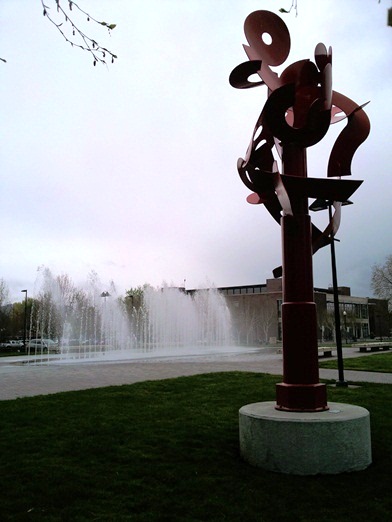[nggallery id=1]
Public spaces need to be built in a way that is both useful and appealing, and public art can play a vital role there. I remember attending a transportation conference in New Delhi where a case was cited of using public art to transform a solid waste management plant that was hated by residents into a community area where kids play today. I remember listening to that case as if it were a distant dream. Not that distant anymore, because the city of Portland is a hub for public art.
When I walk to work every day, I cross this brilliant iron-cast statue of a woman. She looks stunning as she stands at the centre of a semi-circular seating area where the tired walker ocassionaly rests or smokers converge (most other roads in the area are tobacco-free zones). This statue is located on an otherwise busy intersection (Oregon Steet and 7th Avenue) and falls along the last leg of my journey from home to work. So by the time I reach it, I am usually tired. But the statue unfailingly instills a renewed vigour in me, preparing me for the final stretch as well as the rest of the day. To a weary traveler, a wonderful sight can be extremely refreshing.
And that is the power of public art. Involving artists in a multi-disciplinary approach has huge benefits. Art allows mundane buildings and facades to look exciting (such as the Portlandia sculpture); it can enable the conversion of unattractive intersections and crossings into relaxing public spaces and stop-overs (like the Pioneer Square structure); it can increase the utility of a public space by providing seating space (like the Oregon Street statue); it can increase safety by providing barriers between cars and pedestrians (such as the sculptures placed along the road to Portland State University); and it can also increase the appeal and the number of visitors to a shopping district (such as the fountain built of stone coins alongside Nordstrom in Lloyd district).
Recognizing the need for public art, the state of Oregon passed the Percent for Art legislation in 1975, becoming the third government in the US to pass the legislation. With the early accordance of priority to public art, Oregon’s art collection has grown over 30 years to showcase 1545 unique creations.
The City of Portland helps fund public art by requiring participating bureaus to contribute a percentage of eligible improvement project costs (new construction and major building alteration) to its Percent for Art programme. The programme is implemented by the Regional Arts and Culture Council through various public-private partnerships and has been recently audited to suggest further improvements.
In addition to enlivening public spaces and corridors and making them more walkable and livable, official acquisition of public art has also given a major boost to the very talented artists’ community in this region. The programme has been a key patron for the growing art community that is creating legacies every day.

